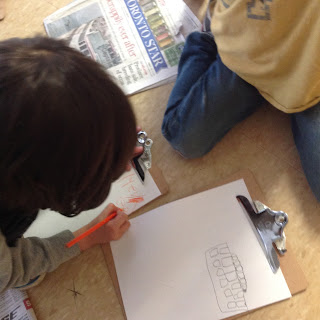But first, a brief backstory...
Once upon a time it was a beloved dinner outing for families and many Torontonians fondly recall the red velvet interior and luxurious lobster meals. However, after going bankrupt, closing down and falling into dis-repair, the former "floating seafood restaurant" has become notorious for being a bit of an eyesore. Love it or hate it, it's certainly a well known part of Toronto's waterfront. Given that many of our students live in this area, and pass Captain John's daily, it was no surprise that they were all abuzz when it was announced that the boat was going to be towed away from the harbour after being there since 1975.
And this is where our project begins! Here is the initial documentation we tweeted out that describes the project's initial spark:
We were excited to see the new direction students wanted to take at our Dramatic Centre. Later that day, in one of our Learning Centre blocks, we were stunned when a group of students worked together on this incredibly detailed and thoughtful representation of Captain John's using the open ended materials found in our classroom's Art Studio:
Sensing the high level of engagement and interest in this real life event, we provided students additional opportunities through research, collaboration, and critical thinking to consider how we could create a "Captain John's dramatic centre". Some photos of the process are below, along with documented small group conversations. This process was incredibly important (moreso than the product, really) as it allowed students to share and build knowledge. It removed myself and the other classroom educator as "experts" and resulted in the students coming up with their own ideas on how to design and build the boat. Giving the students this independence and ownership over their learning is instrumental in the project approach and results in authenticity in the final work.
As we continued these conversations and took part in additional research (including a community parent who works on a boat coming in to answer our questions!) we then entered the construction phase, and students chose to use the initial drawing of the boat as a prototype. Using leftover foam core from the school musical as well as cardboard donated from families, our inspired students got to work. Again, throughout this Reggio inspired process, we as teachers positioned ourselves as active participants and co-learners. We were never "in charge" of this process, and were delighted in how so many students let their leadership and teamwork skills shine. As well, we observed all sorts of mathematical conversations and thinking about measurement and spatial reasoning as students went through the process. Another benefit of the project approach is that it allows students to fulfill curricular expectations in meaningful and play-based ways.
(this is one of my favourite shots - a student so engrossed in the project he didn't want to stop for his snack!)
It should also be noted that in a project approach no student is ever forced into it. If Reggio is truly about following student interest, we have to leave room for the fact that not all students may be interested. While many students chose to work together in the ship's creation, several others opted to continue learning at our other play based areas in the room, and we had no problem with this. Again, we strive to keep things authentic at all times. It was neat to observe, however, how the project naturally expanded to involve these other learning centres. A group of students who were not involved in the actual construction decided to use our Writing Centre to create a menu for the restaurant inside the ship. Students used their emerging literacy skills in this exciting extension of the original project and we as educators happily went along with it!
Students worked incredibly hard on every aspect of the project, and as we got closer and closer to completion it was lovely to see the pride students had in their work. I stopped to reflect on the fact that this pride, not to mention all the learning that had taken place, would have been completely missed if this dramatic centre was teacher selected and teacher created.
Today, all the parts were put finally together - and our very own Captain John's floating restaurant officially opened in Room 109. There were customers, chefs, waiters, and yes, even students playing the part of the Captain himself! Excitement was at an all time high, and students took part in dramatic play in an area completely inspired, designed, created, and built by them.
______________
Child-centered practice, hands-on learning, imagination, creativity, collaboration, critical thinking, cross-curricular expectations, authenticity, student ownership, independence, pride, and JOY - this is why I love Reggio and the project approach.





















No comments:
Post a Comment